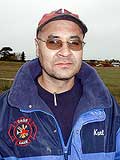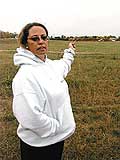|
Audio
Photos
Resources
Respond to this story
|
Leech Lake Superfund site still a health hazard
October 24, 2002
Federal officials say a contaminated Superfund site on the Leech Lake reservation may still pose health risks. The St. Regis Paper Co. operated a wood treatment plant near downtown Cass Lake for nearly 30 years. It was added to the Environmental Protection Agency's Superfund list in 1984. Now, the EPA says recent tests show high levels of dioxin, a chemical that causes cancer. Agency officials say it's premature to conclude the site is causing health problems. But local residents are convinced the contamination is to blame for high cancer rates, birth defects and other illnesses.
 | |||
Karl Humphrey grew up on the south side of the tracks in Cass Lake. It was a poor neighborhood, home mostly to Native Americans. The houses were surrounded by piles of treated logs destined to become railroad ties and telephone poles.
The St. Regis wood treatment plant is gone now. It was located on 125 acres between Pike Bay and Cass Lake. The plant used chemicals like pentachlorophenol and creosote to preserve the logs. Those chemicals contain dioxin and can cause cancer. Humphrey, who is now an environmental researcher for the Minnesota Chippewa tribe, says the site is still dirty and dangerous.
"You can see some of the treated material that's still left here, full of dioxin," says Humphrey. "About a year ago one of my co-workers at the lab and I came and took a sample from here. And it was just screaming with dioxin. There's a hunk there."
For decades, sludge from the wood treatment process was dumped in on-site disposal ponds, or buried or burned at the nearby city landfill. Neighborhood kids had to walk through the area to get to school.
Leech Lake band member Paula Valiant grew up in the neighborhood in the 1960s. She says the ponds and the stacks of logs were their playground.
"We'd go there and play. That's the only place we had, because we were totally surrounded by the creosote logs. And the pits," says Valiant. "That's where we learned to pull canoes around and swim, actually. I'm not joking. That's where we went."
 | |||
Valiant says people who lived on the site all those years were never told their health might be in danger. Now, they believe the contamination is to blame for chronic health problems that span generations.
"No wonder all of our families are dying of cancer, and all these other diseases and medical problems," says Valiant. "Every family that we know that lived over here, we can give you a name of one person in their family that has cancer, or has already died of cancer."
Humphrey lived in the neighborhood for 20 years and worked at the wood treatment plant.
"I have a grandson that was born without a thumb," he says. "He also has a crooked spine, two extra vertebrae, a misshaped kidney."
Cleanup at the St. Regis site began in 1984. That's when it became a priority for the Environmental Protection Agency. That same year, the Minnesota Pollution Control Agency took over the site. It's a move some have questioned.
The PCA advised the owner, then Champion International, to put in a groundwater treatment plant. Champion also built a containment vault to store contaminated soil. International Paper Co. purchased Champion two years ago and is now responsible for the cleanup.
About 10 years ago, Leech Lake officials began to question why the state, and not the federal government, was overseeing the cleanup. The tribe says the state's testing wasn't thorough, and there was no detailed chemical analysis. Gerald White, who heads the band's natural resources division, says Leech Lake was left out of the process.
"I think both the EPA and the state of Minnesota dropped the ball when they had an opportunity to do a thorough investigation of the site and all the contaminants that are present here," White says.
White says he suspects the contamination is causing health problems in the community, but he doesn't have proof. He says working with state and federal agencies to get answers has been a struggle.
"I think if this was in a rich suburb of Minneapolis, or any other community that has a lot more resources than we have, the determination would have been different," White says. "I mean, let's get real here. Most of the environmental justice concerns are in communities of color and poor communities."
White says he and other tribal leaders began pressuring the MPCA and the EPA to do a more detailed investigation. Last year, the EPA conducted soil and water tests. They also collected tissue samples from fish that swim in the nearby lakes. At a recent public meeting, the EPA announced that whitefish tested in Cass Lake and Pike Bay have dioxin levels 10 times higher than those from a lake further from the site.
Dr. Milton Clark, health and science advisor with the EPA, says frequent consumption of the contaminated fish could be risky.
"The wood treatment site, we believe, because of the soil and sediment data, appears to be the source of the dioxins that we do see in the whitefish," says Clark. "We do need to get more information about the fish harvesting in the area. That is, all fish, including the whitefish, and meal consumption rates."
Leech Lake Band members are allowed to net whitefish. It's a regular part of their diet. The agency now recommends that people eat no more than 12 meals of whitefish per year from the two lakes.
The EPA took 20 soil samples last year from a residential neighborhood near the Superfund site. All of them exceeded the agency's acceptable levels for dioxin exposure.
Sherri Newago moved to Cass Lake 13 months ago. She bought a house near the Superfund site. No one warned her the property may be contaminated.
"We had no disclosure from the Realtor, the person we bought the house from, the city, nobody," says Newago. "(I'm) very concerned about the safety, health of my family. I ... don't even like my son to play outside. He goes from the car into the house."
Some of the property around the Superfund site is owned by the city of Cass Lake. The city continues to sell residential lots there. Mayor Dean Brascalla says there are no restrictions or disclosure requirements for selling land outside the original Superfund boundaries. But would Brascalla buy a lot in that neighborhood?
"I would think twice about it," Brascalla says. "Good question, good hypothetical. I would look very hard at it with the information they're saying, that dioxin is in the ground over there."
The EPA is cautious about responding to community concerns. Officials are telling people not to panic. They acknowledge the contamination poses long term risks, but they say there's not enough data to determine short term risks. Administrators at the Cass Lake Indian Hospital are equally cautious.
"We do have higher rates of cancer, and certainly some immune diseases in this community, than on the average," says Dr. Diane Pittman, the hospital's clinical director. "As to exactly what the cause of that is, can't say for sure... But certainly we know that dioxins can cause some of those diseases, and we're very concerned about the contamination."
The EPA plans more soil and water testing of the St. Regis site. Then they'll determine a plan for further cleanup. Meanwhile, another federal agency, the Agency for Toxic Substances and Disease Registry, will soon begin a comprehensive evaluation of Cass Lake's health history. A draft report should be available to the public within a few months, but a complete health study could take years.
|
News Headlines
|
Related Subjects
|
